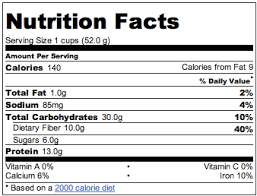
To many, the beginning of March signifies the sprint to St.Patty's and warm weather. The thoughts of leaning your chair back, sipping ice tea, and enjoying warm weather eases the mind and captures the heart. To add to these wonderful things that March brings us, it also brings the National Nutrition Month (NMN)! The month-long event/celebration is intended to bring more awareness to food choices that are healthier. The primary sponsor of NMN is the
Academy of Nutrition and Diabetics (AND) formally known as the
American Diabetic Association. The focus of this campaign is to make "informed food choices and developing sound eating and physical activity habits." As quoted on the AND website:
www.eatright.org.
The AND has had a long history of controversy, which is a natural by-product of the business of telling people how to eat. The company's membership, sponsorships, and partnerships have been consistently scrutinized. In recent news there has been controversies surrounding the AND and their partnership with "Big Food" companies such as:
Coca-Cola, Hershey, PepsiCo, Mars, National Dairy Council, and many more. These "Big Food" companies, it is said, have more say in the company than most of the nutritionist do, thus creating the conflict. Furthermore, The AND receives, on average, $1 million a year from the Pharmaceutical Industry. As a form of presumed reciprocity the AND helps some of these pharmaceutical companies in their marketing and public relation efforts. Taken together, all of these facts lead some to think that the AND is securely in the pocket of big corporate companies, whose initiatives run completely counter to their own philosophies and purpose.
Whether you agree with the critics or supporters of the AND, one thing we can all agree on is that nutrition awareness is a good thing. The significance of this notion is further increased when we considered the high rates of obesity and diabetes in America today.In the past thirty years child obesity has doubled and tripled in America alone. The rate of adulthood has doubled in the past thirty years. Twelve states currently have an adult obesity rating over thirty percent. Here are some tips to keep your body healthy:
The Mediterranean Diet:
1.) Meats and sweets should be consumed less often in this diet.
2.) Poultry, eggs, cheese, and yogurt should be consumed in moderate portions, but should be consumed daily to weekly.
3.) Fish and seafood should be consumed often, at least two times per week.
4.) Fruits, vegetables, grains (whole), olive oil, beans, nuts, legumes, seeds, herbs and spices should be based on every meal you eat.
A proven study has shown while on the Mediterranean diet it reduces your risk of heart disease, the risk of overall and cardiovascular mortality, cancer and cancer mortality, and it reduces the incidence of Parkinson's and Alzheimer's diseases.
According to
Mayoclinic.com:
"The Mediterranean diet emphasizes:
- Getting plenty of exercise
- Eating primarily plant-based foods, such as fruits and vegetables, whole grains, legumes and nuts
- Replacing butter with healthy fats such as olive oil and canola oil
- Using herbs and spices instead of salt to flavor foods
- Limiting red meat to no more than a few times a month
- Eating fish and poultry at least twice a week
- Drinking red wine in moderation (optional)
The diet also recognizes the importance of enjoying meals with family and friends."
The second diet is intended specifically for diabetics. Studies show that 25.8 million children and adults in the United States- 8.3% of the population-have diabetes. But here is a great diet for diabetics:
The Diabetic Diet:
1.) Healthy Carbs: Yes there is such a thing! Avoid carbs such as sugars and starches. Focus more on the healthier cards such as: fruits, vegetables, and whole grains.
2.) Fiber-rich foods: such as nuts whole bran foods, and whole flour foods.
Remember that nuts are still a "fatty" food so they should not be eaten in large amounts. Just one hand full a day should be enough. Also, try to avoid nuts that are covered in salt, and honey roasted.
3.) Fish: Try eating fish that are rich in omega-3 such as: salmon mackerel, and herring. Avoid any tilefish swordfish and king mackerel due to high levels of mercury.
4.) 'Good' Fats: Avocado, almonds, pecans, walnuts, olives, canola, olive, and peanut oil are all considered to be 'good' fats.
Now that you have some tips to stay healthy and active try to change some the things you eat. Whether it be eating less red meats and more fish or eating out less and more with your family. Please share any facts or risks you know about obesity and diabetes with friends and family members to make National Nutritional Month a success!
 Bunions, also called Hallux Abducto Valgus (HAV), are a deformity characterized by a lateral deviation of the great toe (hallux) with a subsequent medial prominence ("bump".) The medial prominence is from the underlying deviated prominent bone (not a growth), and sometimes can form an overlying bursitis which may add to the prominence (usually very painful and red.) Bunions form when your big toe pushes up against your other toes, forcing your big toe joint in the opposite direction. Over time, the abnormal position enlarges your big toe joint, further crowding your other toes and causing pain.
Bunions, also called Hallux Abducto Valgus (HAV), are a deformity characterized by a lateral deviation of the great toe (hallux) with a subsequent medial prominence ("bump".) The medial prominence is from the underlying deviated prominent bone (not a growth), and sometimes can form an overlying bursitis which may add to the prominence (usually very painful and red.) Bunions form when your big toe pushes up against your other toes, forcing your big toe joint in the opposite direction. Over time, the abnormal position enlarges your big toe joint, further crowding your other toes and causing pain.




